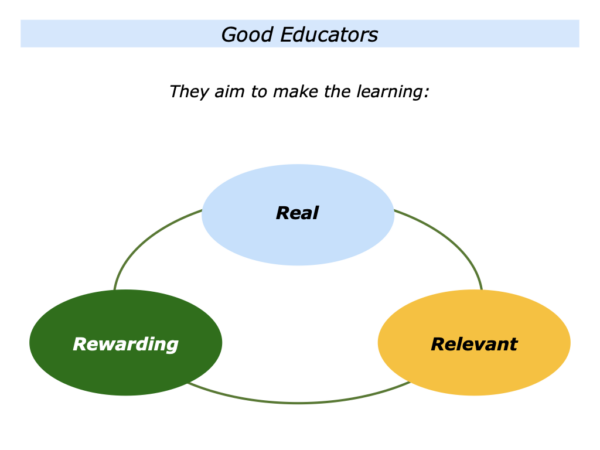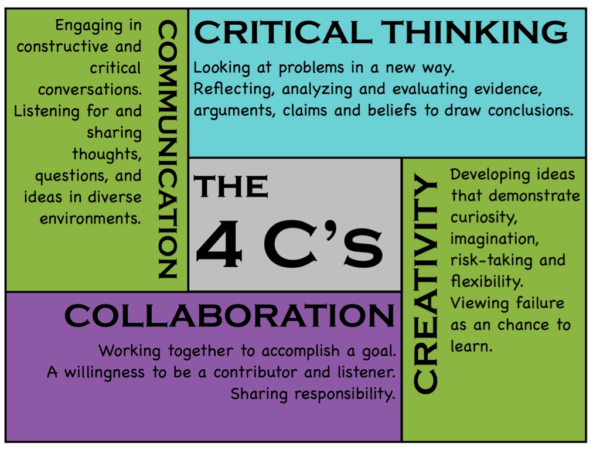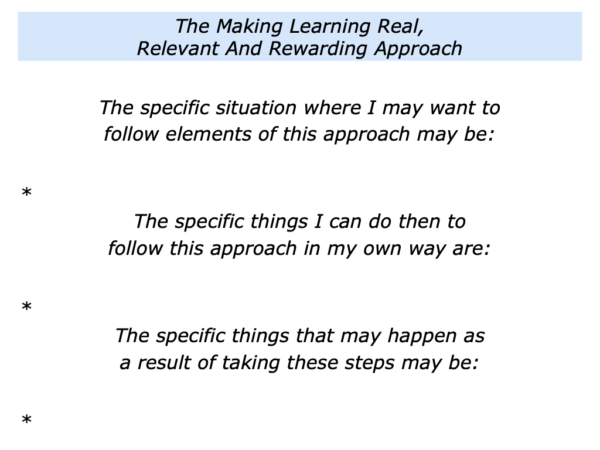
There are many models for helping people to grow. One approach is to make the learning real, relevant and rewarding. Let’s explore these themes.
Making Learning Real
People want to learn things that resonate with them and relate to their agendas. Good educators often follow these rules. They aim to focus on a person’s real experience and real goals. They then help the person to negotiate reality and achieve success.
This approach can be applied in many situations. It can be followed when working with students, adult learners, executives or other people. People are more likely to learn if they feel it will help them to succeed in the real world.
Such an approach has a long tradition in education. It became well-established in Europe by thinkers such as Pestalozzi, Froebel and Montessori.
John Dewey was one of the first to promote it in the United States and his influence remains to this day. Many of his ideas are embodied in what are now sometimes called the Four Cs of 21st Century Skills.
These are eternal skills, of course, that have featured in many educational approaches. Here is an overview of the skills.

Many educational organisations and companies now promote these skills. Below is excerpt from the website of The Partnership For 21st Century Skills.
We have a clear mission. We aim:
To serve as a catalyst to position 21st century readiness at the center of US K12 education by building collaborative partnerships among education, business, community and government leaders.
Twenty-First Century Children
Every child in the U.S. needs 21st century knowledge and skills to succeed as effective citizens, workers and leaders. This can be accomplished by fusing the 3Rs and 4Cs.
There is a profound gap between the knowledge and skills most students learn in school and the knowledge and skills they need in typical 21st century communities and workplaces.
To successfully face rigorous higher education coursework, career challenges and a globally competitive workforce, U.S. schools must align classroom environments with real world environments by fusing the 3Rs and 4Cs:
The 3Rs include: English, reading or language arts; mathematics; science; foreign languages; civics; government; economics; arts; history; and geography.
The 4Cs include: critical thinking and problem solving; communication, collaboration; and creativity and innovation.
As the 3Rs serve as an umbrella for other subjects and core content, the 4Cs are a shorthand for all the skills needed for success in college, career, and life.
Imagine that you are following elements of this approach when helping a person to group of people to learn. You may then move on to the next step.
Making Learning Relevant
Good educators recognise that many people are pragmatists. People want the learning to be relevant. They also want to know how to apply it in a practical situation.
Bearing this in mind, it is vital to invite a person to describe the specific things they want to learn. Here are some themes they may mention.
I want to learn …
How to take the next step in my career … How manage my anger in a specific situation … How to manage a talented but challenging person in my team … How to deal with my boss who is a micromanager.
How to recover my zest for life … How to get more satisfaction from my work … How to ensure my great team stays ahead of the game … How to give an effective keynote speech … How to feel more at peace.
Imagine that a person has described the topic they want to explore. It can then important to focus on a specific example or situation. Bearing this in mind, you may say something along the following lines.
As far as I understand it, you want to focus on how to …? Looking at what you want to achieve, can we look at a specific example?
What is happening in that situation? What would you like to happen? What are the real results you would like to achieve? What is your picture of success? What would be the benefits of achieving these goals?
Bearing these things in mind, as far as I understand it, the real results you want to achieve are:
* To …
* To …
* To …
Are there any other things you want to achieve? Is it okay for me to share some ideas and practical tools you may be able to use? These are based on what works but you will, of course, use these in your own way.
Imagine that you have clarified the results the person wants to achieve. You can then aim to pass on practical tools that the person can use to achieve their goals. This takes us to the next step.
Making Learning Rewarding
People like to do what works. They like to feel they have learned something valuable and have also achieved success. Educators therefore sometimes take the following steps to make the learning real, relevant and rewarding. They aim:
To clarify what the person wants to learn and the real results they want to achieve;
To pass on relevant knowledge and tools that the person can use to achieve these results;
To enable the person to achieve these results and find the experience to be rewarding.
A teacher may follow this approach to help a student to develop a skill. A sports coach may follow it to help an athlete improve. A consultant may follow it to help a managing director tackle a challenge in their company.
This approach has a long tradition in education. Maria Montessori, for example, encouraged children to focus on things they wanted to learn and continue until they had achieved what she called their ‘inner goal’.
Imagine that you are visiting a Montessori class for the youngest children. You will probably see over 30 children spanning a three-year age range.
The room has a prepared environment in which
children can follow their natural tendency to work.
It will embody the characteristics of beauty, simplicity, order, accessibility and reality. Children will have many enticing materials that are designed to help them explore their world and develop their skills.
The children will be ‘working’.
Some will be totally concentrated on their activity; some will be co-operating with others; some will be tidying up after their last activity and moving onto the next. Some may be preparing food. Some may be engaged in other activities.
The children will be given freedom to work and move around within
suitable guidelines that enable them to act as part of a social group.
They can pursue their own interests. They will also be encouraged to respect others and, when appropriate, work to with them to achieve certain goals.
The educator will be watching the children.
They will see when they become enraptured, follow their flow and, when appropriate, encourage and guide them to further exploration on this theme.
The children will continue to develop their skills,
repeating an activity until it satisfies an ‘inner goal’.
They will continue until they feel satisfied with the work they have done. They will then move onto the next activity they want to explore.
Looking ahead, can you think of a situation where you may want to make the learning real, relevant and rewarding? How can you do this in your own way?
If you wish, try tackling the exercise on this theme. This invites you to complete the following sentences.







Leave a Reply